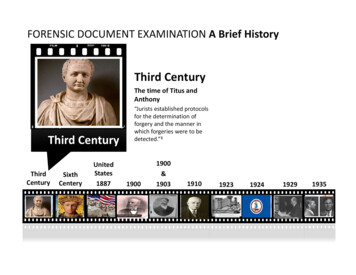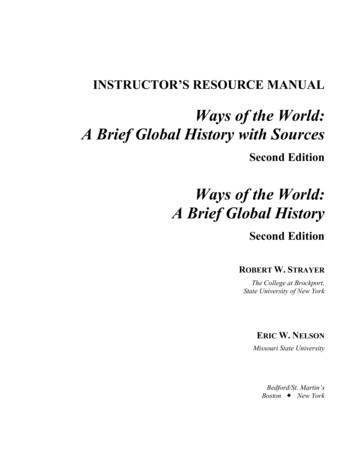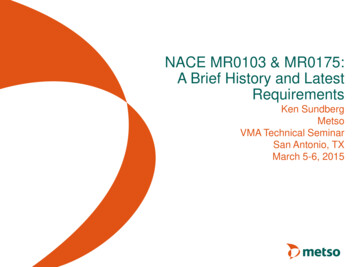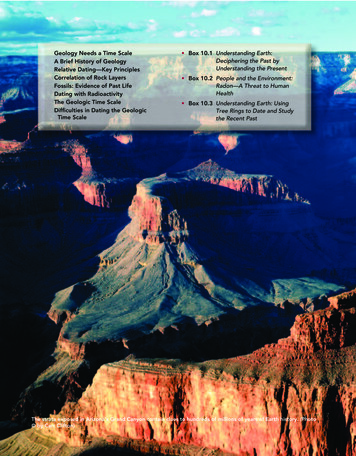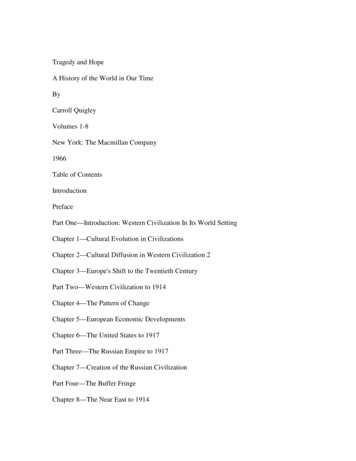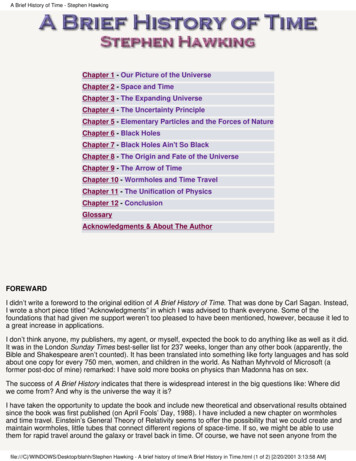
Transcription
A Brief History of Time - Stephen HawkingChapter 1 - Our Picture of the UniverseChapter 2 - Space and TimeChapter 3 - The Expanding UniverseChapter 4 - The Uncertainty PrincipleChapter 5 - Elementary Particles and the Forces of NatureChapter 6 - Black HolesChapter 7 - Black Holes Ain't So BlackChapter 8 - The Origin and Fate of the UniverseChapter 9 - The Arrow of TimeChapter 10 - Wormholes and Time TravelChapter 11 - The Unification of PhysicsChapter 12 - ConclusionGlossaryAcknowledgments & About The AuthorFOREWARDI didn’t write a foreword to the original edition of A Brief History of Time. That was done by Carl Sagan. Instead,I wrote a short piece titled “Acknowledgments” in which I was advised to thank everyone. Some of thefoundations that had given me support weren’t too pleased to have been mentioned, however, because it led toa great increase in applications.I don’t think anyone, my publishers, my agent, or myself, expected the book to do anything like as well as it did.It was in the London Sunday Times best-seller list for 237 weeks, longer than any other book (apparently, theBible and Shakespeare aren’t counted). It has been translated into something like forty languages and has soldabout one copy for every 750 men, women, and children in the world. As Nathan Myhrvold of Microsoft (aformer post-doc of mine) remarked: I have sold more books on physics than Madonna has on sex.The success of A Brief History indicates that there is widespread interest in the big questions like: Where didwe come from? And why is the universe the way it is?I have taken the opportunity to update the book and include new theoretical and observational results obtainedsince the book was first published (on April Fools’ Day, 1988). I have included a new chapter on wormholesand time travel. Einstein’s General Theory of Relativity seems to offer the possibility that we could create andmaintain wormholes, little tubes that connect different regions of space-time. If so, we might be able to usethem for rapid travel around the galaxy or travel back in time. Of course, we have not seen anyone from thefile:///C /WINDOWS/Desktop/blahh/Stephen Hawking - A brief history of time/A Brief History in Time.html (1 of 2) [2/20/2001 3:13:58 AM]
A Brief History of Time - Stephen Hawkingfuture (or have we?) but I discuss a possible explanation for this.I also describe the progress that has been made recently in finding “dualities” or correspondences betweenapparently different theories of physics. These correspondences are a strong indication that there is a completeunified theory of physics, but they also suggest that it may not be possible to express this theory in a singlefundamental formulation. Instead, we may have to use different reflections of the underlying theory in differentsituations. It might be like our being unable to represent the surface of the earth on a single map and having touse different maps in different regions. This would be a revolution in our view of the unification of the laws ofscience but it would not change the most important point: that the universe is governed by a set of rational lawsthat we can discover and understand.On the observational side, by far the most important development has been the measurement of fluctuations inthe cosmic microwave background radiation by COBE (the Cosmic Background Explorer satellite) and othercollaborations. These fluctuations are the finger-prints of creation, tiny initial irregularities in the otherwisesmooth and uniform early universe that later grew into galaxies, stars, and all the structures we see around us.Their form agrees with the predictions of the proposal that the universe has no boundaries or edges in theimaginary time direction; but further observations will be necessary to distinguish this proposal from otherpossible explanations for the fluctuations in the background. However, within a few years we should knowwhether we can believe that we live in a universe that is completely self-contained and without beginning orend.Stephen Hawkingfile:///C /WINDOWS/Desktop/blahh/Stephen Hawking - A brief history of time/A Brief History in Time.html (2 of 2) [2/20/2001 3:13:58 AM]
A Brief History of Time - Stephen Hawking. Chapter 1CHAPTER 1OUR PICTURE OF THE UNIVERSEA well-known scientist (some say it was Bertrand Russell) once gave a public lecture on astronomy. Hedescribed how the earth orbits around the sun and how the sun, in turn, orbits around the center of a vastcollection of stars called our galaxy. At the end of the lecture, a little old lady at the back of the room got up andsaid: “What you have told us is rubbish. The world is really a flat plate supported on the back of a gianttortoise.” The scientist gave a superior smile before replying, “What is the tortoise standing on.” “You’re veryclever, young man, very clever,” said the old lady. “But it’s turtles all the way down!”Most people would find the picture of our universe as an infinite tower of tortoises rather ridiculous, but why dowe think we know better? What do we know about the universe, and how do we know it? Where did theuniverse come from, and where is it going? Did the universe have a beginning, and if so, what happened beforethen? What is the nature of time? Will it ever come to an end? Can we go back in time? Recent breakthroughsin physics, made possible in part by fantastic new technologies, suggest answers to some of theselongstanding questions. Someday these answers may seem as obvious to us as the earth orbiting the sun – orperhaps as ridiculous as a tower of tortoises. Only time (whatever that may be) will tell.As long ago as 340 BC the Greek philosopher Aristotle, in his book On the Heavens, was able to put forwardtwo good arguments for believing that the earth was a round sphere rather than a Hat plate. First, he realizedthat eclipses of the moon were caused by the earth coming between the sun and the moon. The earth’sshadow on the moon was always round, which would be true only if the earth was spherical. If the earth hadbeen a flat disk, the shadow would have been elongated and elliptical, unless the eclipse always occurred at atime when the sun was directly under the center of the disk. Second, the Greeks knew from their travels thatthe North Star appeared lower in the sky when viewed in the south than it did in more northerly regions. (Sincethe North Star lies over the North Pole, it appears to be directly above an observer at the North Pole, but tosomeone looking from the equator, it appears to lie just at the horizon. From the difference in the apparentposition of the North Star in Egypt and Greece, Aristotle even quoted an estimate that the distance around theearth was 400,000 stadia. It is not known exactly what length a stadium was, but it may have been about 200yards, which would make Aristotle’s estimate about twice the currently accepted figure. The Greeks even had athird argument that the earth must be round, for why else does one first see the sails of a ship coming over thehorizon, and only later see the hull?Aristotle thought the earth was stationary and that the sun, the moon, the planets, and the stars moved incircular orbits about the earth. He believed this because he felt, for mystical reasons, that the earth was thecenter of the universe, and that circular motion was the most perfect. This idea was elaborated by Ptolemy inthe second century AD into a complete cosmological model. The earth stood at the center, surrounded by eightspheres that carried the moon, the sun, the stars, and the five planets known at the time, Mercury, Venus,Mars, Jupiter, and Saturn.file:///C /WINDOWS/Desktop/blahh/Stephen Hawking - A brief history of time/n.html (1 of 7) [2/20/2001 3:14:06 AM]
A Brief History of Time - Stephen Hawking. Chapter 1Figure 1:1The planets themselves moved on smaller circles attached to their respective spheres in order to account fortheir rather complicated observed paths in the sky. The outermost sphere carried the so-called fixed stars,which always stay in the same positions relative to each other but which rotate together across the sky. Whatlay beyond the last sphere was never made very clear, but it certainly was not part of mankind’s observableuniverse.Ptolemy’s model provided a reasonably accurate system for predicting the positions of heavenly bodies in thesky. But in order to predict these positions correctly, Ptolemy had to make an assumption that the moonfollowed a path that sometimes brought it twice as close to the earth as at other times. And that meant that themoon ought sometimes to appear twice as big as at other times! Ptolemy recognized this flaw, but neverthelesshis model was generally, although not universally, accepted. It was adopted by the Christian church as thepicture of the universe that was in accordance with Scripture, for it had the great advantage that it left lots ofroom outside the sphere of fixed stars for heaven and hell.A simpler model, however, was proposed in 1514 by a Polish priest, Nicholas Copernicus. (At first, perhaps forfear of being branded a heretic by his church, Copernicus circulated his model anonymously.) His idea was thatthe sun was stationary at the center and that the earth and the planets moved in circular orbits around the sun.Nearly a century passed before this idea was taken seriously. Then two astronomers – the German, Johannesfile:///C /WINDOWS/Desktop/blahh/Stephen Hawking - A brief history of time/n.html (2 of 7) [2/20/2001 3:14:06 AM]
A Brief History of Time - Stephen Hawking. Chapter 1Kepler, and the Italian, Galileo Galilei – started publicly to support the Copernican theory, despite the fact thatthe orbits it predicted did not quite match the ones observed. The death blow to the Aristotelian/Ptolemaictheory came in 1609. In that year, Galileo started observing the night sky with a telescope, which had just beeninvented. When he looked at the planet Jupiter, Galileo found that it was accompanied by several smallsatellites or moons that orbited around it. This implied that everything did not have to orbit directly around theearth, as Aristotle and Ptolemy had thought. (It was, of course, still possible to believe that the earth wasstationary at the center of the universe and that the moons of Jupiter moved on extremely complicated pathsaround the earth, giving the appearance that they orbited Jupiter. However, Copernicus’s theory was muchsimpler.) At the same time, Johannes Kepler had modified Copernicus’s theory, suggesting that the planetsmoved not in circles but in ellipses (an ellipse is an elongated circle). The predictions now finally matched theobservations.As far as Kepler was concerned, elliptical orbits were merely an ad hoc hypothesis, and a rather repugnant oneat that, because ellipses were clearly less perfect than circles. Having discovered almost by accident thatelliptical orbits fit the observations well, he could not reconcile them with his idea that the planets were made toorbit the sun by magnetic forces. An explanation was provided only much later, in 1687, when Sir Isaac Newtonpublished his Philosophiae Naturalis Principia Mathematica, probably the most important single work everpublished in the physical sciences. In it Newton not only put forward a theory of how bodies move in space andtime, but he also developed the complicated mathematics needed to analyze those motions. In addition,Newton postulated a law of universal gravitation according to which each body in the universe was attractedtoward every other body by a force that was stronger the more massive the bodies and the closer they were toeach other. It was this same force that caused objects to fall to the ground. (The story that Newton was inspiredby an apple hitting his head is almost certainly apocryphal. All Newton himself ever said was that the idea ofgravity came to him as he sat “in a contemplative mood” and “was occasioned by the fall of an apple.”) Newtonwent on to show that, according to his law, gravity causes the moon to move in an elliptical orbit around theearth and causes the earth and the planets to follow elliptical paths around the sun.The Copernican model got rid of Ptolemy’s celestial spheres, and with them, the idea that the universe had anatural boundary. Since “fixed stars” did not appear to change their positions apart from a rotation across thesky caused by the earth spinning on its axis, it became natural to suppose that the fixed stars were objects likeour sun but very much farther away.Newton realized that, according to his theory of gravity, the stars should attract each other, so it seemed theycould not remain essentially motionless. Would they not all fall together at some point? In a letter in 1691 toRichard Bentley, another leading thinker of his day, Newton argued that this would indeed happen if there wereonly a finite number of stars distributed over a finite region of space. But he reasoned that if, on the other hand,there were an infinite number of stars, distributed more or less uniformly over infinite space, this would nothappen, because there would not be any central point for them to fall to.This argument is an instance of the pitfalls that you can encounter in talking about infinity. In an infiniteuniverse, every point can be regarded as the center, because every point has an infinite number of stars oneach side of it. The correct approach, it was realized only much later, is to consider the finite situation, in whichthe stars all fall in on each other, and then to ask how things change if one adds more stars roughly uniformlydistributed outside this region. According to Newton’s law, the extra stars would make no difference at all to theoriginal ones on average, so the stars would fall in just as fast. We can add as many stars as we like, but theywill still always collapse in on themselves. We now know it is impossible to have an infinite static model of theuniverse in which gravity
imaginary time direction; but further observations will be necessary to distinguish this proposal from other possible explanations for the fluctuations in the background. However, within a few years we should know whether we can believe that we live in a universe that is completely self-contained and without beginning or end. Stephen Hawking A Brief History of Time - Stephen Hawking file .

